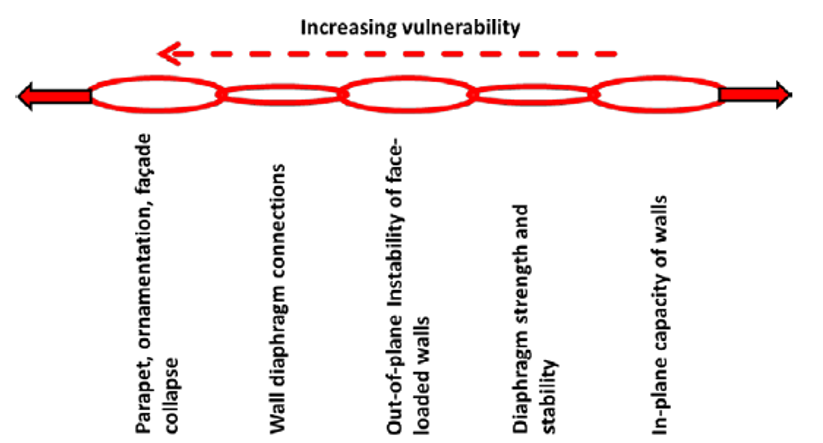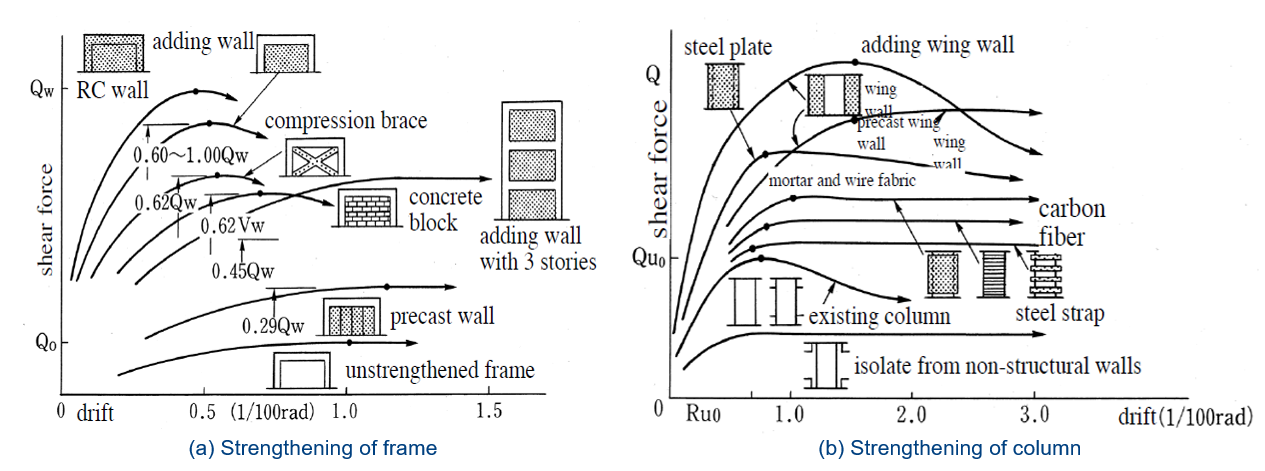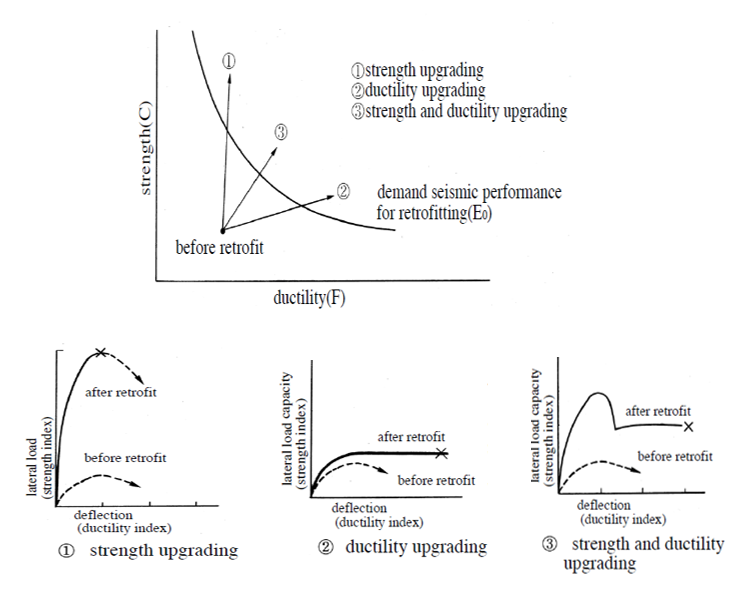How to strengthen
A strategy to assess all elements is to check elements based on the inspection of the so-called vulnerability chain. In the following Figure, rather than focusing on an OOP or IP point of view, a building component check is observed, were usually the order of failure is the one from left to right (e.g. first parapets fail). The sequence of retrofitting actions securing first the safety of the most vulnerable components is desirable before continuing to the next less vulnerable components. Caution should be paid to the seismic load return period used for the evaluation of each component. For example, the failure of primary structural elements may cause a complete collapse of the structure and because of this a longer return period is used. This contrast with failing components that cause only local damage, to which shorter return periods are used.

Figure 124 Sequence of the seismic vulnerability chain (after C8 NZ 2017).
The following sequence of decisions may be utilized to define the NLPO strategy for achieving compliance in the in-plane according to the NPR requirements for the whole building system.
Strategies for the in-plane seismic retrofitting
The NLPO procedure and compliance check according to NPR commented in the section Step A11: Non-Linear flex base push-over analysis can be as well used to evaluate seismic improvement measures for non-NPR compliant structures as it has already been mentioned before in the introduction. The global behavior of the structure, expressed in this procedure by a PO curve, can be modified by the application in the structure of measures or by the specific intervention of few capacity dominant elements.
In the following figure, the effect of a measure in terms of the improved component PO-curve can be observed. Measures can be categorized according to their use to improve ductility and/or capacity. The effect of the measures on the global behavior can be finally expressed in the system PO curve as observed in the figure beneath. The use of retrofitting elements such as dampers and base isolation that also influence the seismic demand.

Figure 125 Effect of a measure.

Figure 126 Effect of a measure on the global behaviour.

Figure 127 Effect of retrofitting elements such as dampers and base isolation.
Action I: Determine suitable strengthening measures
Note
In the NLPO analysis, the strengthening measures are not modelled in DIANA. Strengthening measures are determined in combination with the lead engineer but in the process they are not modelled into DIANA.
If OOP measures have been applied to the building, they must be considered in the procedure, modifying or adding new conditions. Typically, OOP measures are not proposed at the initial stages of the model since retrofitting measures can also be thought to contribute for both the In-Plane and the Out-of-Plane actions. Its relevant to mention here that to consider the In-Plane contribution of some elements (such as not well connected outer leaves in cavity walls) may increment the PO capacity, possibly given an incorrect idea of the seismic performance.
Example of elements that may be updated after the application of strengthening measures are:
Considering the outer layers of well-connected cavity walls (well connected by providing reinforcement or verification of the connections after inspection),
changing connection conditions at the diaphragms (due to OOP measures),
change properties for strengthened diaphragms (required when diaphragms fail the limiting deformation criteria. Caution is required since strengthened diaphragms may change the overall response of the structure (induce torsion)),
adding the OOP measures (thinking also that they may be effective also for the IP if required from the initial IP assessment and the location of the measures is suitable), and
segregation or linking of building sections (separation/linking of extensions of the building such a garage, storage, is a consequence after the OOP and/or diaphragms retrofit).
Action II: Check compliance of the structural model from action I and/or include localized minor interventions
The structure condition after OOP and/or adding other minor interventions, such as strengthening of a critical element, may had improve also the IP behavior of the structure. In particular, if an OOP measure is effective for both OOP and IP retrofit.
This action can be very effective when the structure is already close to comply with the NPR 9998-2019. Usually localized interventions that can be tested are:
Segregation or linking of building sections (separation/linking of extensions such a garage, storage, etc),
change of failure modes, FM, of components (for instance neglect brittle FM by assuring this FM may be avoided by the implementation of a measure),
improve/provide connectivity in between walls and floors, and
provide connectivity, if absent, in between walls and walls (activate flange effect).
Action III: Reduction/Redistribution of the Seismic mass
If compliance for the in-plane is not expected to be found from the previous step, to reduce the mass by removal of heavy elements (such as substitution of the roof type) or to change the load path for the elements in the structure can be considered. The effects of mass reduction and/or redistribution are in most of the cases is positive, but it most be performed carefully. The following comments are related with this action:
The spectral acceleration capacity of building will be possibly incremented since the effective mass is reduced either by reduction of the mass or redistribution to other structural elements or to newly added structural elements (observe point (2)),
brittle failure modes may be avoided by reducing or redirecting overburden loads. This action usually implies a reduction of the base shear capacity but bring other advantages due to the ductile response of the structure,
in relation to the base shear reduction, the lateral and vertical loads on the foundation will be decreased (vertical may be of importance specially in case of piles),
when the roof is changed to a rigid light weigh solution, the roof will tend to participate less in the seismic response (so activate as a block rather than with local deformation, valid mainly for small roofs). Cation is required here since this may change the failure mode of structural elements,
the change of heavy non-structural URM walls to lightweight walls, is a positive measure for mass reduction. Moreover, when the walls also require OOP reinforcement,
load redistribution activities are more suitable to be perform at the wall to floor connections or by providing additional load bearing beams or additional columns to redistribute the floor loads,
remove or relocate upper levels heavy components such as those located at the roof (water tanks, electromechanical equipment, chimneys, etc).
Action IV: Improve the global ductile behavior and/or provide redundancy to prevent collapse
If compliance for the in-plane is not found from the previous steps or mass reduction actions are not feasible/sufficient, to improve the global ductile behavior may be preferred before adding measures that mostly increment the strength of the structure lateral capacity. Also, to improve the behavior by adopting measures to enhance the redistribution of seismic actions after elements are damaged; hence providing structural redundancy, is desirable. The following are actions that will promote ductile behavior and/or a more equal distribution of damage in between elements:
Adding vertical slips cuts or windows and weakening of spandrels in URM may change the global behavior from brittle to ductile. This measure is usually combined with some strengthening intervention of the piers to further guarantee the desired behavior,
selective weakening. Improvement of ductility by selective weakening of the structure is a measure that should be applied with care. For instance, when applying measures, like for example cutting steel bars in RC frames beams, it is recommended to use it in combination with a strengthening measure, so that, at least a similar base shear capacity of the original system can be archived.
improve ductility of elements by jacketing. For example, fiber jacketing or steel jacketing,
improvement of vibration property. For instance, by reducing the influence of torsional modes by a reduction of eccentricity (in combination with action III) or improvement of stiffness irregularity,
improvements of diaphragms and connections to redistribute loads in case of damaged elements to provide redundancy. In particular, useful for regular configuration structures since for irregular structures this action may generate undesirable torsional effects, and
provide an independent structure that provides redundancy to the structure in case of failure of structural critical components. Example of this is the addition of steel frames to carry the vertical when an element fails (no common and mainly can be used to prevent total collapse).
Action V: Increase the structure strength
If compliance for the in-plane is not found from the previous steps, to add in-plane global structural strengthening measures is necessary. These measures are least preferable due to the following consequences:
Reduction of the living space in the structure or closing of windows or doors,
it may affect greatly the architectural style,
it will increase the base shear capacity of the structure. This means that the necessity of improving the foundation as well is increased. Foundation strengthening works can be expensive, and
long period of execution of the intervention.
Measures for strengthening of the structure may be the following:
Adding further lateral capacity elements like inner infill walls or internal frames
Adding of external frames and/or buttress
Demolish and reconstruction of the structural members.
Action VI: Decrease of the seismic action by base isolation or/and structural control devices
In occasions, particularly when low levels of damage or no-damage limits states are pursued, the use of base isolation in combination with dampers or the use of seismic dampers may be justified. In action III, the reduction of mass is also considered a measure that reduces the seismic forces.
Other considerations of importance for seismic retrofit
Improving heritage buildings Many heritage buildings are either earthquake prone or earthquake risk buildings. While the assessment of these buildings will generally follow the same principles as other buildings, their improvement requires more careful consideration in order to determine an acceptable upgrading strategy. In practice, this often requires a significant degree of compromise between heritage impact and structural upgrading objectives. This is outside the scope of this document, but the principles outlined herein will be generally applicable.
Improving buildings in proximity of other structures Urban environment structures are usually connected or in close proximity with other structures; this can be observed for instance with many URM buildings in the Groningen area. Improving the performance of an individual structure that is either structurally connected to or expected to be affected by one or more other structures requires careful consideration (A10.2.3.3 NZ 2017).